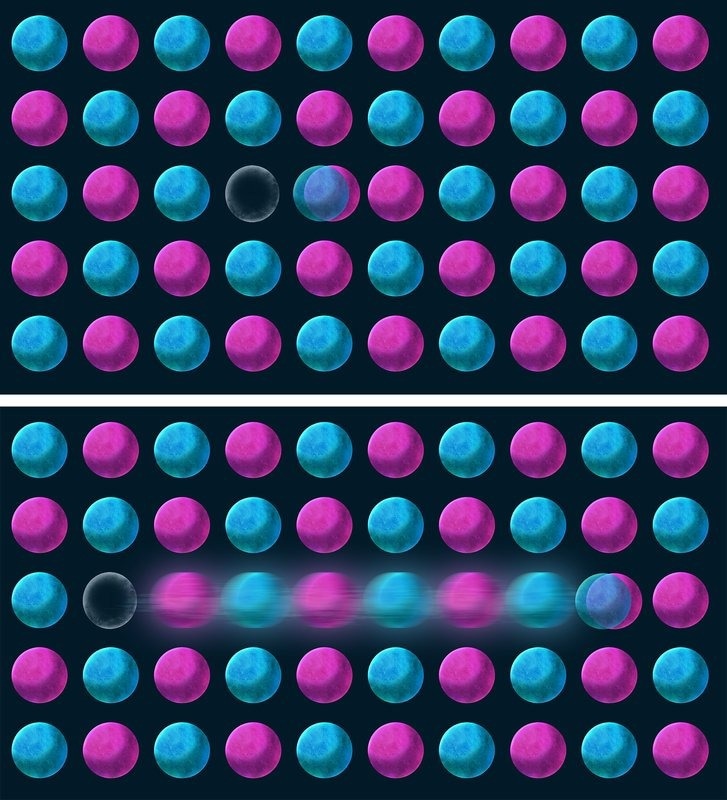In art, the negative space in a painting can almost be as essential as the painting itself. Similarly, with insulating materials, the empty spaces created by missing electrons play an important role in defining the material’s characteristics. When a negatively charged electron is stimulated by light, it leaves a positive hole in its wake. Since the hole and electron are charged in opposing directions, they are attracted to one other and form a bond. The ensuing short-lived pair is known as an exciton [pronounced exit-tawn].

In materials known as antiferromagnetic Mott insulators, electrons (orbs) are organized in a lattice structure of atoms such that their spins point up (blue) or down (pink) in an alternating pattern. This is a stable state in which the energy is minimized. When the material is hit with light, an electron will hop to a neighboring atomic site, leaving a positively charged hole where it once resided (dark orb). If the electron and hole move further apart from each other, the spin arrangement between them becomes disturbed—the spins are no longer pointing in opposite directions to their neighbors as seen in the second panel—and this costs energy. To avoid this energy penalty, the electron and hole prefer to remain close to each other. This is the magnetic binding mechanism underlying the Hubbard exciton. Image Credit: Caltech
Excitons are used in a variety of technologies, including solar panels, photodetectors and sensors, and light-emitting diodes used in TVs and digital display displays. Most exciton pairs are held together by electrical or electrostatic forces, often known as Coulomb interactions.
Caltech researchers describe discovering excitons that are not constrained by Coulomb forces but rather by magnetism in a new study published in Nature Physics. This is the first attempt to detect how these so-called Hubbard excitons, named after the late physicist John Hubbard, develop in real time.
Using an advanced spectroscopic probe, we were able to observe in real time the generation and decay of magnetically bound excitons, the Hubbard excitons.
Omar Mehio, Postdoctoral Fellow, Kavli Institute, Cornell University
Mehio added, “In most insulators, oppositely charged electrons and holes interact with one another just as an electron and a proton bind to form a hydrogen atom. However, in a special class of materials known as Mott insulators, the photo-excited electrons and holes instead bind through magnetic interactions.”
The findings might aid in the development of novel exciton-related technologies, or excitonics, in which excitons are controlled using their magnetic characteristics.
“Hubbard excitons and their magnetic binding mechanism demonstrate a drastic departure from the paradigms of traditional excitonics, creating the opportunity to develop a whole ecosystem of novel technologies that are fundamentally unavailable in conventional excitonic systems. Having excitons and magnetism strongly intertwined in a single material could lead to new technologies that harness both properties,” Mehio noted.
The researchers used light to make the Hubbard excitons by passing it through an antiferromagnetic Mott insulator. These are magnetic materials with repeated, stable patterns of electron spin alignment. The light causes electrons to fly to neighboring atoms, creating holes in their wake.
Mehio further added, “In these materials, when an electron or hole moves through the lattice, they leave in their wake a string of magnetic excitations. Imagine you tie one end of an elastic rope around your friend, and the other end around yourself. If your friend runs away from you, you will feel the rope pull you in that direction and you will begin to follow. This scenario is analogous to what happens between a photo-excited electron and the hole it leaves behind in a Mott insulator. With Hubbard excitons, the string of magnetic excitations between the pair serves the same role as the rope connecting you to your friend.”
The researchers utilized a technique called ultrafast time-domain terahertz spectroscopy, which allowed them to search for the extremely fleeting traces of the excitons at very low-energy scales to prove the existence of the Hubbard excitons.
Excitons are unstable because the electrons want to go back into the holes. We have a way of probing the short time window before this recombination occurs, and that allowed us to see that a fluid of Hubbard excitons is transiently stabilized.
David Hsieh, Donald A. Glaser Professor, Physics, Caltech Institute of Technology
The study project, “A Hubbard exciton fluid in a photo-doped antiferromagnetic Mott insulator,” was supported by the Army Research Office, the David and Lucile Packard Foundation, the National Science Foundation, the Institute for Quantum Information and Matter at Caltech (an NSF Physics Frontiers Center), Caltech, the German Research Foundation, the Gordon and Betty Moore Foundation, and the Slovenian Research Agency.
Yuchen Han, a graduate student at Caltech, Xinwei Li, Honglie Ning (PhD ‘23), Nicholas Laurita, Zala Lenari of the Jozef Stefan Institute in Slovenia and UC Berkeley, Michael Buchhold of the University of Cologne in Germany (and a former postdoc at Caltech), Zach Porter, and Stephen Wilson of UC Santa Barbara are the other authors.
Journal Reference:
Omar, M., et al. (2023) A Hubbard exciton fluid in a photo-doped antiferromagnetic Mott insulator. Nature Physics. doi:10.1038/s41567-023-02204-2.